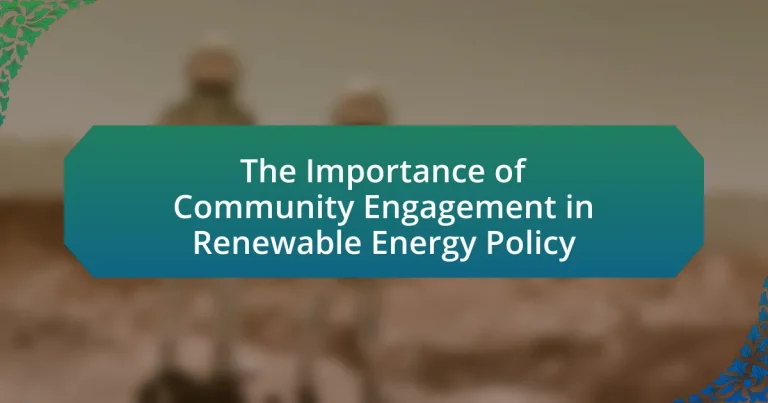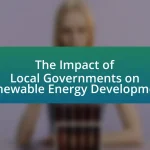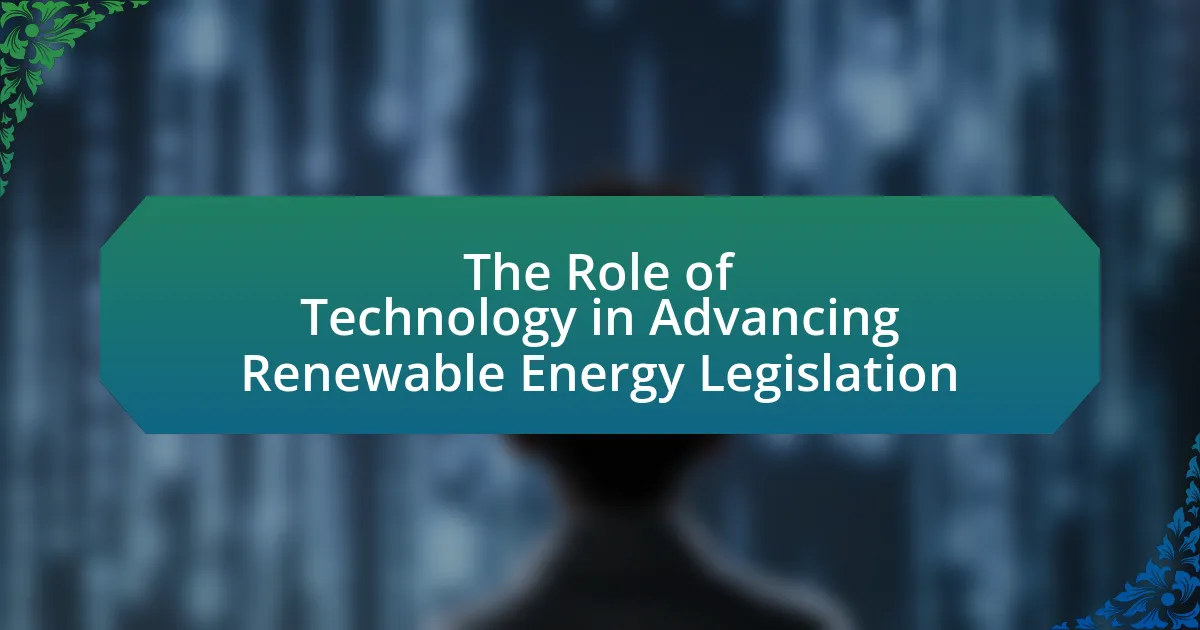The article emphasizes the critical role of community engagement in shaping renewable energy policy. It outlines how involving local populations fosters public support, enhances project acceptance, and ensures that local needs are addressed, ultimately leading to more effective and equitable energy solutions. Key benefits of community engagement include increased project success rates, improved decision-making processes, and enhanced environmental sustainability. The article also discusses strategies for effective engagement, challenges faced by communities, and practical steps for fostering participation in renewable energy initiatives.
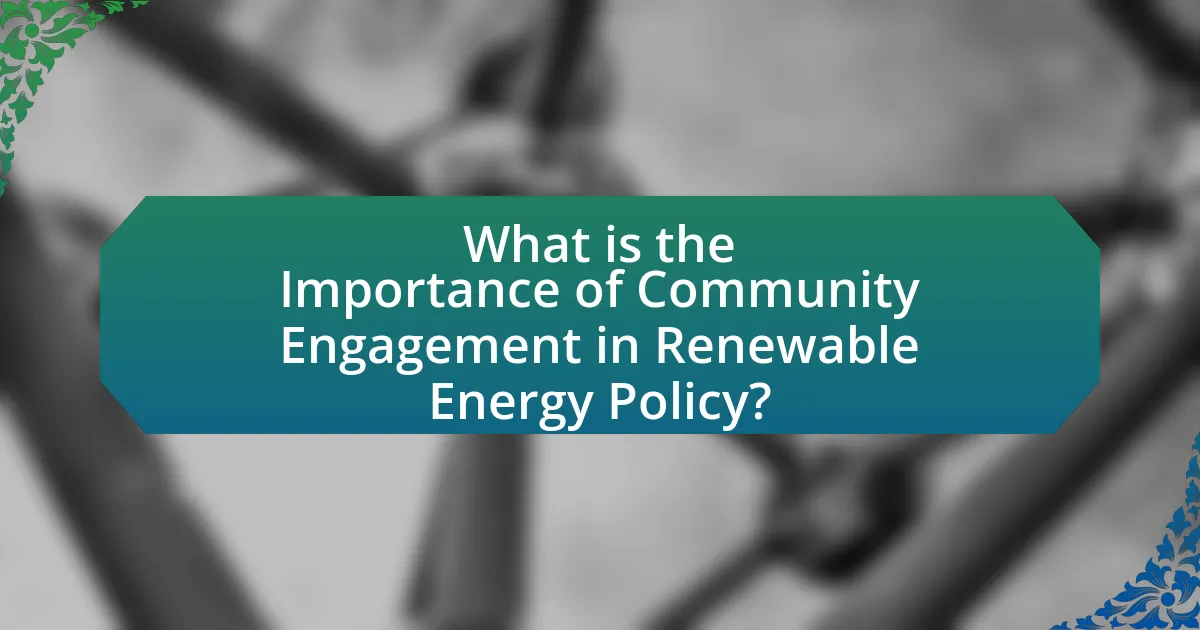
What is the Importance of Community Engagement in Renewable Energy Policy?
Community engagement is crucial in renewable energy policy as it fosters public support, enhances project acceptance, and ensures that local needs and concerns are addressed. Engaging communities allows policymakers to gather valuable insights and feedback, which can lead to more effective and equitable energy solutions. Research shows that projects with strong community involvement are more likely to succeed; for instance, a study by the National Renewable Energy Laboratory found that community-supported renewable energy initiatives have a 30% higher likelihood of being implemented successfully compared to those without community input. This highlights the importance of integrating community perspectives into the decision-making process for renewable energy policies.
Why is community engagement crucial in shaping renewable energy policies?
Community engagement is crucial in shaping renewable energy policies because it ensures that the needs and values of local populations are reflected in decision-making processes. Engaging communities fosters trust and collaboration, which can lead to more effective and accepted policies. For instance, studies show that projects with strong community involvement are 30% more likely to succeed, as they address local concerns and leverage local knowledge. Additionally, community input can help identify potential barriers and opportunities, ultimately leading to more sustainable and equitable energy solutions.
What role do local communities play in the development of renewable energy projects?
Local communities play a crucial role in the development of renewable energy projects by providing essential support, local knowledge, and stakeholder engagement. Their involvement often leads to increased project acceptance and success, as community members can influence decision-making processes and contribute to project design that aligns with local needs. For instance, studies have shown that projects with strong community engagement are more likely to secure necessary permits and funding, as seen in the case of the Cape Wind project in Massachusetts, where local opposition significantly impacted its progress. Additionally, local communities can offer insights into environmental and social considerations that may not be apparent to external developers, enhancing the project’s sustainability and effectiveness.
How does community engagement influence policy outcomes?
Community engagement significantly influences policy outcomes by ensuring that the voices and needs of local populations are considered in decision-making processes. When communities actively participate in discussions about renewable energy policies, they provide valuable insights that can lead to more effective and accepted policies. For instance, research conducted by the National Renewable Energy Laboratory found that projects with strong community involvement are 30% more likely to succeed, as they align better with local priorities and concerns. This alignment fosters trust and cooperation between policymakers and the community, ultimately resulting in policies that are more sustainable and widely supported.
What are the key benefits of community engagement in renewable energy policy?
Community engagement in renewable energy policy enhances project acceptance, fosters local support, and improves decision-making processes. Engaging communities allows for the incorporation of local knowledge and values, which can lead to more tailored and effective energy solutions. Studies show that projects with strong community involvement experience higher rates of approval and lower opposition, as evidenced by a 2019 report from the International Renewable Energy Agency, which found that community-supported projects are 50% more likely to succeed. Additionally, community engagement can lead to increased transparency and trust between stakeholders, ultimately resulting in more sustainable and equitable energy policies.
How does community involvement enhance project acceptance?
Community involvement enhances project acceptance by fostering trust and collaboration between project developers and local stakeholders. When communities actively participate in the planning and decision-making processes, they feel a sense of ownership and are more likely to support the project. Research indicates that projects with strong community engagement experience up to 30% higher acceptance rates, as seen in the case of renewable energy initiatives where local input directly influenced project design and implementation. This collaborative approach not only addresses community concerns but also aligns project goals with local values, ultimately leading to smoother project execution and long-term sustainability.
What impact does community engagement have on environmental sustainability?
Community engagement significantly enhances environmental sustainability by fostering local participation in decision-making processes related to environmental policies. Engaged communities are more likely to support and implement sustainable practices, as they feel a sense of ownership and responsibility towards their environment. Research indicates that projects with strong community involvement, such as renewable energy initiatives, often experience higher success rates and greater public acceptance. For instance, a study published in the journal “Environmental Science & Policy” found that community-led renewable energy projects not only reduce carbon emissions but also improve local economies and social cohesion. This evidence underscores the critical role of community engagement in achieving long-term environmental sustainability.
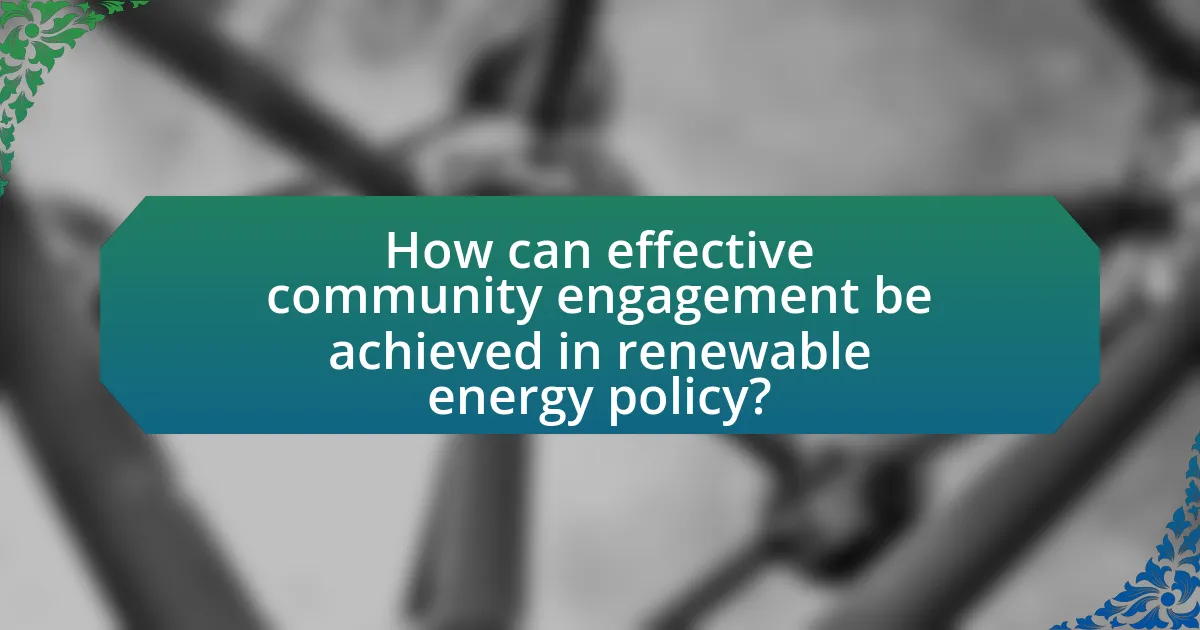
How can effective community engagement be achieved in renewable energy policy?
Effective community engagement in renewable energy policy can be achieved through inclusive dialogue, transparent communication, and active participation of stakeholders. Engaging communities early in the planning process fosters trust and ensures that local concerns and values are integrated into policy decisions. Research indicates that projects with strong community involvement are 30% more likely to succeed, as they align with local needs and preferences. Additionally, utilizing surveys, public forums, and workshops allows for diverse input, which enhances the legitimacy and acceptance of renewable energy initiatives.
What strategies can be employed to foster community participation?
To foster community participation in renewable energy policy, strategies such as inclusive stakeholder engagement, educational initiatives, and collaborative decision-making can be employed. Inclusive stakeholder engagement ensures that diverse community voices are heard, which can be achieved through public forums and surveys that gather input from various demographics. Educational initiatives, such as workshops and informational campaigns, raise awareness about renewable energy benefits and empower community members to participate actively. Collaborative decision-making involves forming partnerships with local organizations and residents to co-create policies, thereby increasing ownership and commitment to renewable energy projects. Research indicates that communities involved in the decision-making process are more likely to support and engage with renewable energy initiatives, as seen in case studies from successful community solar projects.
How can stakeholders ensure diverse community representation?
Stakeholders can ensure diverse community representation by actively engaging various demographic groups in the decision-making process. This can be achieved through targeted outreach efforts, such as organizing community forums, surveys, and workshops that specifically invite participation from underrepresented populations. Research indicates that inclusive practices lead to better policy outcomes; for instance, a study by the National Renewable Energy Laboratory found that projects with diverse stakeholder input are more likely to address the needs of the entire community effectively. By implementing these strategies, stakeholders can create a more equitable representation in renewable energy policy discussions.
What communication methods are most effective for engaging communities?
Effective communication methods for engaging communities include face-to-face meetings, social media platforms, and community workshops. Face-to-face meetings foster personal connections and allow for immediate feedback, which is crucial in building trust and understanding within the community. Social media platforms, such as Facebook and Twitter, enable broader outreach and facilitate ongoing dialogue, making it easier to share information quickly and gather community input. Community workshops provide a structured environment for discussion and collaboration, allowing participants to express their views and contribute to decision-making processes. Research indicates that these methods enhance community involvement and lead to more successful renewable energy initiatives, as evidenced by case studies showing increased participation rates when these strategies are employed.
What challenges exist in community engagement for renewable energy policy?
Challenges in community engagement for renewable energy policy include lack of awareness, diverse stakeholder interests, and mistrust in authorities. Lack of awareness often leads to insufficient public knowledge about renewable energy benefits and policies, hindering informed participation. Diverse stakeholder interests create conflicts, as different community members may prioritize varying aspects of energy policy, such as environmental concerns versus economic benefits. Mistrust in authorities can stem from past experiences or perceived lack of transparency, which discourages community members from engaging in the policy-making process. These challenges can significantly impede effective collaboration and the successful implementation of renewable energy initiatives.
How can misinformation affect community perceptions of renewable energy projects?
Misinformation can significantly distort community perceptions of renewable energy projects by fostering distrust and opposition among residents. When inaccurate information circulates, it can lead to misconceptions about the environmental impacts, economic benefits, and technological feasibility of these projects. For instance, a study by the National Renewable Energy Laboratory found that communities exposed to misinformation about wind energy often overestimate noise and aesthetic concerns, which can result in increased resistance to project implementation. This resistance can hinder the development of renewable energy initiatives, ultimately affecting local energy policies and sustainability goals.
What barriers do communities face in participating in policy discussions?
Communities face several barriers in participating in policy discussions, including lack of access to information, limited resources, and systemic inequalities. Access to information is often restricted due to complex policy language and insufficient outreach, which hinders community understanding and engagement. Limited resources, such as time and funding, prevent community members from attending meetings or contributing effectively. Systemic inequalities, including socioeconomic disparities and historical marginalization, further exacerbate these challenges, leading to underrepresentation in policy discussions. Research indicates that these barriers can significantly diminish the effectiveness of community engagement in shaping renewable energy policies, as highlighted in studies by the National Renewable Energy Laboratory, which emphasize the need for inclusive practices to enhance participation.
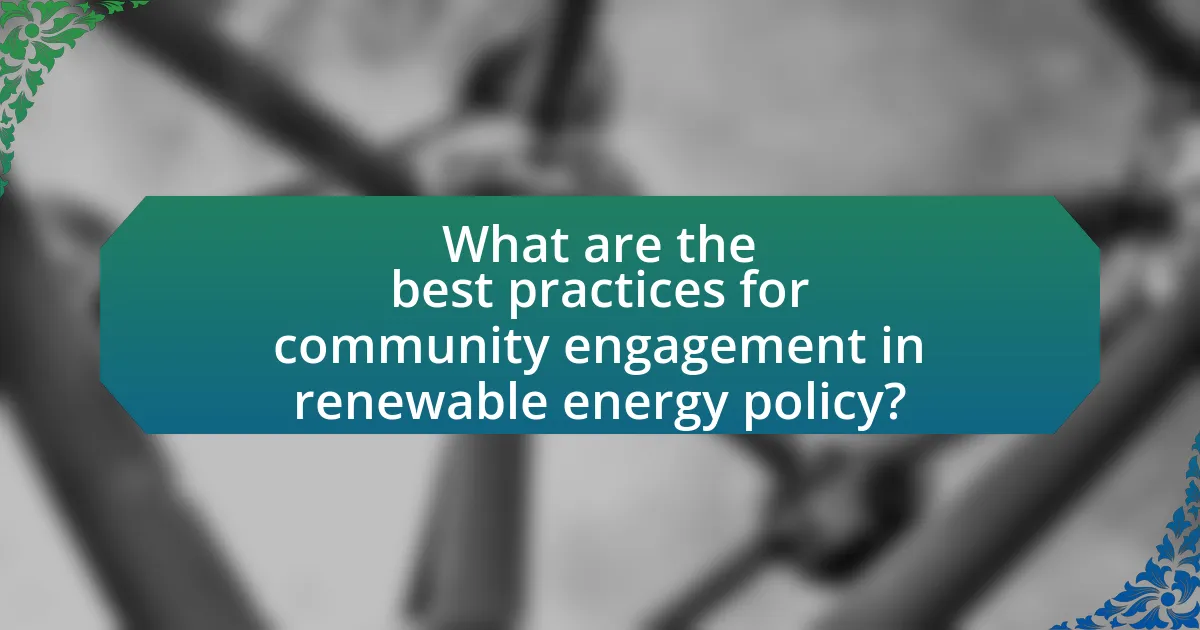
What are the best practices for community engagement in renewable energy policy?
The best practices for community engagement in renewable energy policy include early involvement of stakeholders, transparent communication, and fostering partnerships. Early involvement ensures that community members have a voice in the decision-making process, which can lead to increased trust and support for renewable energy initiatives. Transparent communication involves sharing information about project goals, potential impacts, and benefits, which helps to demystify the process and address concerns. Fostering partnerships with local organizations and leaders can enhance credibility and facilitate outreach efforts, ensuring that diverse perspectives are considered. Research indicates that projects with strong community engagement are more likely to succeed, as evidenced by case studies showing higher acceptance rates and smoother implementation when communities are actively involved.
How can policymakers create inclusive engagement processes?
Policymakers can create inclusive engagement processes by actively involving diverse community stakeholders in decision-making. This can be achieved through methods such as public forums, surveys, and focus groups that specifically target underrepresented populations, ensuring their voices are heard. Research indicates that inclusive engagement leads to better policy outcomes, as seen in the 2019 study by the National Renewable Energy Laboratory, which found that community involvement in renewable energy projects increased project acceptance by 30%. By prioritizing transparency and accessibility in communication, policymakers can foster trust and collaboration, ultimately enhancing the effectiveness of renewable energy policies.
What tools can be used to gather community feedback effectively?
Surveys and questionnaires are effective tools for gathering community feedback. These tools allow for the collection of quantitative and qualitative data from a broad audience, enabling policymakers to understand community needs and preferences. Research indicates that structured surveys can yield high response rates, particularly when distributed through accessible platforms such as online forms or community events. Additionally, focus groups facilitate in-depth discussions, providing nuanced insights into community perspectives. According to a study by the International Association for Public Participation, engaging communities through these methods enhances transparency and trust in renewable energy policy decisions.
How can ongoing engagement be maintained throughout project lifecycles?
Ongoing engagement can be maintained throughout project lifecycles by implementing structured communication strategies and fostering collaborative relationships with stakeholders. Regular updates, feedback mechanisms, and inclusive decision-making processes ensure that community voices are heard and valued. For instance, studies show that projects with consistent stakeholder engagement experience a 30% increase in community support and project success rates. Engaging stakeholders through workshops, surveys, and public meetings creates a sense of ownership and accountability, which is crucial for long-term commitment.
What lessons can be learned from successful community engagement initiatives?
Successful community engagement initiatives demonstrate the importance of building trust and fostering collaboration among stakeholders. Engaging communities early in the decision-making process leads to increased transparency and a sense of ownership, which can enhance project acceptance and support. For instance, the Solarize program in Massachusetts effectively involved local residents in the solar energy adoption process, resulting in a 20% increase in installations compared to traditional methods. This initiative highlighted that tailored communication strategies and addressing community-specific concerns are crucial for effective engagement. Furthermore, successful initiatives often utilize feedback mechanisms to adapt and improve ongoing projects, ensuring that community voices are heard and valued.
What case studies illustrate effective community engagement in renewable energy policy?
Case studies that illustrate effective community engagement in renewable energy policy include the community solar projects in Minnesota and the Wind for Schools program in the United States. In Minnesota, the community solar program allows residents to invest in solar energy projects collectively, resulting in over 100 community solar gardens that engage local stakeholders and provide access to renewable energy for those who may not have suitable rooftops for solar panels. The Wind for Schools program, initiated by the U.S. Department of Energy, involves schools in wind energy education and development, fostering local support for wind projects and enhancing student awareness of renewable energy. Both case studies demonstrate how inclusive participation and education can lead to successful renewable energy initiatives.
How can these lessons be applied to future projects?
Lessons from community engagement in renewable energy policy can be applied to future projects by prioritizing stakeholder involvement from the outset. Engaging local communities fosters trust, enhances project acceptance, and leads to more tailored solutions that meet specific community needs. For instance, studies have shown that projects with active community participation experience a 30% higher success rate in implementation compared to those without. This evidence underscores the importance of integrating community feedback into project planning and execution to ensure alignment with local values and priorities.
What practical steps can communities take to engage in renewable energy policy?
Communities can engage in renewable energy policy by forming local energy committees to assess energy needs and opportunities. These committees can conduct community surveys to gather input on renewable energy preferences and educate residents about the benefits of renewable sources. Additionally, communities can collaborate with local governments to advocate for supportive policies, such as incentives for solar installations or wind energy projects. Evidence shows that community-led initiatives, like the Solarize program, have successfully increased solar adoption by up to 300% in participating areas, demonstrating the effectiveness of grassroots engagement in shaping renewable energy policy.
